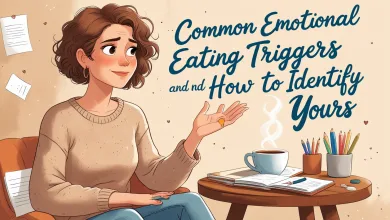The Science Behind Stress Eating: Why We Crave Comfort Foods

Ever found yourself elbow-deep in a pint of ice cream after a rough day? You’re not alone. The science behind stress eating reveals fascinating connections between our brains, bodies, and those irresistible comfort foods we crave when anxiety strikes.
We’ve all been there—deadline looming, tensions high, and suddenly that bag of chips or chocolate bar becomes utterly irresistible. Stress eating is such a common human experience that it’s become a cultural cliché, but have you ever wondered what’s actually happening in your brain and body during these moments? The science behind stress eating goes far deeper than simple willpower or emotional weakness. It’s a complex interplay of hormones, neural pathways, evolutionary biology, and psychological responses that can feel downright impossible to overcome.
In this comprehensive guide, we’ll dive into the fascinating mechanisms behind why we reach for comfort foods during times of anxiety, unpack the difference between physical and emotional hunger, and explore evidence-based strategies that can help break the cycle. Whether you’re occasionally finding solace in a cookie after a tough meeting or noticing more persistent patterns of emotional eating, understanding the science can be your first step toward a healthier relationship with food and stress management.
The Stress Response: Your Body in Survival Mode
When stress hits, your body doesn’t distinguish between a looming work presentation and a prehistoric predator—it just knows it’s time to gear up for action. This ancient survival mechanism, often called the “fight-or-flight” response, triggers a cascade of physiological changes that originally evolved to help our ancestors survive immediate physical threats.
The moment stress registers, your hypothalamus, a tiny control tower in your brain, sends out the alarm. This activates your adrenal glands to pump out stress hormones, primarily cortisol and adrenaline. Your heart rate quickens, breathing accelerates, and muscles tense up—all preparing you to either face the danger head-on or make a hasty retreat. Fascinating, isn’t it? Your body is essentially preparing for a threat that, in modern times, rarely requires physical combat or escape.
But here’s where things get interesting for our eating habits: cortisol, that primary stress hormone, doesn’t just prep you for action—it also drives hunger. Initially, adrenaline suppresses appetite in the acute stress phase (which makes evolutionary sense—who has time to eat when you’re running from a tiger?). However, if stress persists, as it often does in our modern lives with chronic work pressure or ongoing personal challenges, cortisol hangs around longer than nature intended. This prolonged cortisol exposure stimulates appetite, particularly for high-calorie, high-fat, and high-sugar foods that provide quick energy—exactly what our bodies think we need to fuel that fight-or-flight response.
The Comfort Food Connection: Why Mac and Cheese Feels Like a Hug
Have you ever wondered why certain foods feel so darn comforting when you’re stressed? You’re not imagining things—there’s solid science behind why we gravitate toward specific foods in times of emotional turmoil.
When we’re stressed, our brains crave quick relief, and certain foods deliver just that through their effect on brain chemistry. Carbohydrate-rich and fatty foods trigger the release of dopamine, the “feel-good” neurotransmitter that activates your brain’s reward center. That instant gratification creates a powerful reinforcement loop: stress → eat comfort food → feel temporary relief → remember this solution for next time. This pattern gets hardwired into our neural circuitry, making the association between emotional discomfort and certain foods increasingly automatic over time.
But there’s more to comfort foods than just brain chemistry. Many of our comfort food preferences have deep psychological roots in childhood experiences and cultural backgrounds. That bowl of chicken soup might remind you of being cared for when sick as a child. The mac and cheese might evoke memories of carefree afternoons after school. These psychological associations add another layer to why certain foods become our go-to emotional salves.
“Food memories are among our most powerful associations,” explains Dr. Susan Albers, clinical psychologist and author of “Eating Mindfully.” “The brain tags foods we enjoyed during positive emotional states as ‘rewards,’ creating lasting connections between those specific foods and feelings of comfort or happiness.”
Emotional vs. Physical Hunger: Spotting the Difference
One of the trickiest aspects of managing stress eating is learning to distinguish between emotional hunger and genuine physical hunger. They may both prompt you to head to the kitchen, but they originate from entirely different places and serve different purposes.
Physical hunger develops gradually, usually several hours after your last meal. It’s often accompanied by tangible signals like a growling stomach, mild fatigue, or even a slight headache. When physically hungry, you’re generally open to various food options—that spinach salad might sound just as appealing as pasta. Once you’ve eaten enough to satisfy your body’s energy needs, you’ll feel comfortable stopping.
Emotional hunger, on the other hand, tends to come on suddenly and feels much more urgent—like it needs immediate satisfaction. It’s typically triggered by uncomfortable feelings rather than an empty stomach. You might crave very specific comfort foods, and find yourself fixating on particular textures, flavors, or even brands. Perhaps most tellingly, emotional eating often continues well past physical fullness, sometimes leaving you with feelings of guilt or shame rather than satisfaction.
Learning to recognize these differences can be a game-changer in developing a healthier relationship with food. Try asking yourself these questions when cravings strike:
- Did this hunger come on suddenly or gradually?
- Am I craving one specific food, or would I eat anything nutritious?
- Am I responding to a feeling or physical symptoms of hunger?
- Will I feel guilty after eating this?
- Can I identify a specific emotion or stressor I’m experiencing right now?
These simple self-check questions can help create a moment of awareness before automatically reaching for food in response to emotions.
The Stress-Eating Cycle: Why It’s Hard to Break
If you’ve ever found yourself caught in a seemingly endless loop of stress, eating, guilt, and more stress, you’re experiencing what experts call the stress-eating cycle. This persistent pattern isn’t just frustrating—it’s reinforced by powerful biological and psychological mechanisms that make it particularly challenging to overcome.
The cycle typically begins with a stressful trigger—perhaps a work deadline, relationship conflict, or even watching anxiety-provoking news. This stress activates your body’s cortisol response, which as we’ve learned, increases appetite particularly for calorie-dense foods. You eat these comfort foods, which temporarily reduce stress through their effects on brain chemistry. But this relief is short-lived, and often followed by feelings of guilt or shame about having “given in” to emotional eating.
Here’s where it gets especially tricky: those negative feelings about yourself become additional stressors, triggering more cortisol and restarting the whole cycle. It’s a self-perpetuating loop that can feel impossibly difficult to escape, especially when comfort eating has become your primary stress management strategy.
“The stress-eating cycle is maintained by both physiological pathways and learned behavior patterns,” explains obesity researcher Dr. Ashley Mason. “Each time we respond to stress with eating, we strengthen the neural pathways connecting these behaviors, making the automatic response stronger the next time we face similar emotional discomfort.”
Breaking free from this cycle requires addressing both the physical stress response and developing new emotional coping strategies—something we’ll explore in depth in the next sections.
Mindful Eating: Becoming Aware of Emotional Triggers
Mindful eating represents one of the most powerful tools for disrupting the automatic nature of stress eating. At its core, mindfulness is about bringing conscious awareness to your eating experiences—noticing hunger and fullness cues, recognizing emotional triggers, and being present with your food without judgment.
This approach begins with simply slowing down. Many of us eat while distracted—scrolling through our phones, watching TV, or working—which makes it nearly impossible to register satisfaction signals or recognize emotional eating as it happens. By creating space between your emotions and your eating behaviors, you introduce a crucial moment for choice.
Try incorporating these mindful eating practices into your routine:
- Before eating, take three deep breaths and check in with your hunger level on a scale of 1-10
- Remove distractions and focus on the sensory experience of your food—colors, smells, textures, and flavors
- Put your utensils down between bites and chew thoroughly
- Periodically pause during meals to reassess your hunger level
- When cravings hit, use the “5-minute rule”—wait five minutes before deciding if you still want to eat
“Mindful eating isn’t about perfect eating, but rather about being present and intentional with food choices,” says Dr. Jean Kristeller, founder of the Center for Mindful Eating. “This awareness creates a space for choice, even in moments of stress, rather than falling into automatic patterns.”
With consistent practice, mindful eating can help rewire the neural pathways that have linked stress and eating, allowing you to respond to emotional discomfort in more varied and effective ways.
Alternative Stress-Relief Strategies: Beyond the Kitchen
While understanding the science behind stress eating is crucial, equally important is developing a diverse toolkit of stress management techniques that don’t involve food. When we rely exclusively on eating to cope with difficult emotions, we limit our emotional resilience and perpetuate the stress-eating cycle.
The good news? Science has identified numerous effective stress-reduction approaches that can help regulate your nervous system and cortisol levels without a single bite. Consider these evidence-based alternatives:
- Physical movement: Even brief exercise sessions release endorphins, nature’s stress fighters. A 10-minute walk can reduce cortisol levels and improve mood. Try taking a quick stroll when cravings hit.
- Deep breathing: Activating your parasympathetic nervous system through slow, deep breaths can halt the stress response in its tracks. The 4-7-8 technique (inhale for 4 counts, hold for 7, exhale for 8) is particularly effective.
- Progressive muscle relaxation: Systematically tensing and relaxing muscle groups reduces physical tension associated with stress and can be done anywhere in just a few minutes.
- Emotional journaling: Writing about stressful experiences for even 5-10 minutes has been shown to reduce cortisol levels and provide emotional release.
- Social connection: Talking with a supportive friend activates oxytocin, which counteracts cortisol’s effects. Even a brief text exchange can shift your emotional state.
“The key is finding stress-management techniques that feel accessible and enjoyable to you personally,” advises Dr. Elizabeth Scott, stress management expert. “Different approaches work for different people and situations. Having multiple strategies ensures you’re never left with food as your only coping mechanism.”
By gradually expanding your stress-response repertoire, you create new neural pathways that make non-food coping mechanisms increasingly automatic when emotional discomfort arises.
Building a Healthier Food Environment: Setting Yourself Up for Success
While internal strategies like mindfulness and stress management techniques are essential, equally important is creating an environment that supports your efforts to break free from stress eating patterns. Our surroundings profoundly influence our eating behaviors, often below the level of conscious awareness.
Research consistently shows that we’re more likely to eat foods that are visible and easily accessible. This means that reorganizing your food environment can significantly reduce stress eating almost without requiring willpower. Consider implementing these evidence-based environmental strategies:
Create distance between yourself and trigger foods by keeping them out of sight or removing them from your home entirely. If certain foods are non-negotiable household staples for others, designate specific cabinets for them and avoid opening those spaces when stressed.
Pre-portion snacks into appropriate serving sizes rather than eating directly from packages, which can lead to mindless overconsumption. Studies show we eat up to 30% more when eating from larger containers.
Prepare grab-and-go healthy snacks that require minimal effort when you’re stressed and hungry. Cut vegetables, portioned nuts, or fruit can satisfy the urge to eat something immediately while giving you time to implement other coping strategies.
“The environment exerts a powerful influence on our eating behaviors, often stronger than our conscious intentions,” explains behavioral scientist Dr. Brian Wansink. “By modifying your surroundings to make healthy choices easier and less healthy choices harder, you effectively change the path of least resistance.”
Remember that environmental changes should feel supportive rather than punitive. The goal isn’t to create a sense of deprivation but rather to engineer your surroundings in ways that naturally support healthier responses to stress.
When to Seek Help: Recognizing Disordered Eating Patterns
While occasional stress eating is a common experience for most people, it’s important to recognize when emotional eating patterns have become more serious and may require professional support. The line between normal emotional eating and disordered eating behaviors can sometimes blur, but there are several warning signs that suggest it’s time to consult a healthcare provider.
Be attentive to these potential red flags:
- Eating in secret or feeling the need to hide your eating habits from others
- Frequently eating past the point of physical discomfort or feeling out of control while eating
- Experiencing intense feelings of shame, guilt, or self-hatred after eating
- Using food consistently as your primary or only coping mechanism for emotions
- Noticing that emotional eating is interfering with your daily functioning, relationships, or health
- Finding that attempts to change your eating patterns lead to extreme anxiety or distress
“Emotional eating exists on a spectrum,” explains eating disorder specialist Dr. Jennifer Thomas. “When food becomes your primary emotional coping tool and is accompanied by significant distress or impairment, professional support can provide more effective strategies and address underlying issues.”
Seeking help isn’t a sign of failure but rather an act of self-care. Many healthcare providers—including psychologists, registered dietitians, and physicians with expertise in disordered eating—can offer evidence-based approaches like Cognitive Behavioral Therapy, which has shown significant effectiveness for emotional eating issues.
Your Questions Answered: Common FAQs About Stress Eating
Q: Is stress eating the same as having a food addiction?
A: While both involve difficult-to-control eating behaviors, they’re not identical. Stress eating is specifically triggered by emotional distress, while food addiction involves reward pathways in the brain that function similarly to substance addictions. Some people experience both, but they require somewhat different treatment approaches. Recent research suggests that highly processed foods may indeed trigger addiction-like neural responses in susceptible individuals.
Q: Can certain foods actually help reduce stress?
A: Yes! While emotional eating often involves foods that temporarily feel good but don’t support long-term wellbeing, certain foods do contain compounds that can help modulate stress response. Foods rich in omega-3 fatty acids (like fatty fish), magnesium (found in leafy greens and nuts), and complex carbohydrates (like oatmeal) can help regulate cortisol levels and support steady mood. Incorporating these foods into your regular diet may help build physiological resilience to stress.
Q: Is it ever okay to eat for emotional reasons?
A: Absolutely! Food has always had social, cultural, and emotional significance for humans. The occasional mindful indulgence in a favorite food for pleasure or celebration is a normal part of a healthy relationship with food. The key difference is awareness and choice—consciously deciding to enjoy something rather than eating on autopilot to avoid emotions. Many experts recommend planning occasional “play foods” into your routine so they become normalized rather than forbidden, reducing their power as stress triggers.
Q: How long does it take to break stress eating habits?
A: There’s no one-size-fits-all timeline, as it depends on how ingrained the patterns are and what new coping skills you’re developing. Generally, forming new neural pathways takes consistent practice over time. Many people notice significant improvements within 3-4 weeks of consistent mindfulness practice and implementation of alternative coping strategies, but deeper pattern changes often evolve over months. Remember that occasional setbacks are a normal part of the process rather than a sign of failure.
The Path Forward: Transforming Your Relationship with Stress and Food
As we wrap up our exploration of the fascinating science behind stress eating, it’s worth remembering that knowledge is just the beginning. Understanding why your brain and body respond to stress by craving those comfort foods is powerful—but transforming this awareness into lasting change requires patience, self-compassion, and consistent practice.
The journey toward a healthier relationship with food and stress isn’t about achieving perfection. It’s about gradually expanding your emotional coping toolkit, becoming more aware of your unique stress triggers, and developing the ability to pause between feeling and action. Each time you recognize an emotional eating urge and choose—even occasionally—to respond differently, you’re literally rewiring neural pathways and building new, more supportive habits.
Remember that stress is an inevitable part of human experience, and emotional eating has likely served an important function in your life up until now. Rather than seeing it as a weakness to overcome, consider it an adaptive strategy that you’re now ready to expand beyond. With the science-backed approaches we’ve explored—from mindfulness practices to environmental modifications to alternative stress-relief techniques—you have numerous paths forward.
“The goal isn’t to never find comfort in food,” notes psychologist Dr. Pavel Somov, “but rather to develop a flexible relationship with both stress and eating that allows you multiple options for responding to life’s challenges.”
As you move forward, celebrate small victories, practice self-compassion during inevitable setbacks, and remember that sustainable change happens through evolution, not revolution. Your brain and body have remarkable capacities for adaptation—and with time, awareness, and practice, you can create new patterns that better serve your overall wellbeing.





